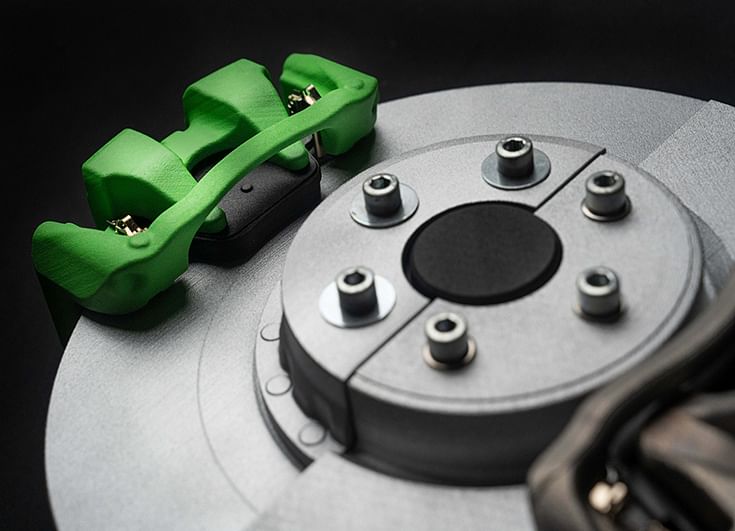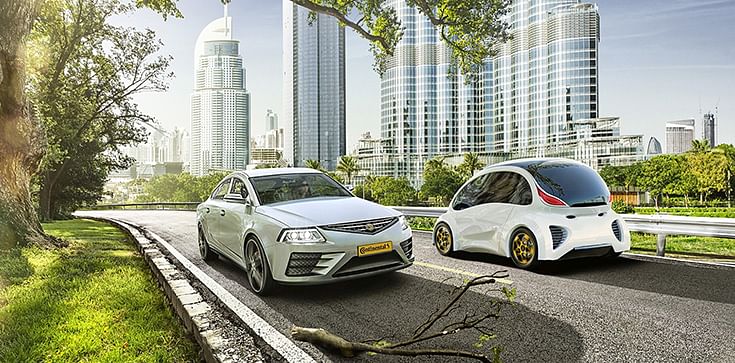Continental develops lighter brake caliper for EVs
The new design can save up to two kilograms in weight per brake caliper plus up to three more kilograms per brake disc, thereby contributing to increased vehicle range.
Technology and component major Continental has announced development of a new brake design which will help deliver additional range to electric vehicles. The so-called 'Green Caliper', a newly developed brake caliper for disc brakes, is significantly lighter than previous designs and has a lower residual brake torque.
In combination with the brake disc, the lower mass – in individual cases up to five kilograms per brake – and the reduced friction between brake pad and disc contribute to increasing the range of an electric vehicle. This major advance was made possible by targeted further development to meet the requirements of a brake in an electric vehicle.
Unlike the brakes in a conventional vehicle, those in an electric car are activated much less frequently. This is because in over 80 percent of all deceleration situations, the brake is not needed at all due to recuperation. However, this does not mean that the Green Caliper have to be able to do less than a conventional brake caliper.
On the contrary, because of the weight of the battery in an electric car, the deceleration performance of the brakes often has to be even higher. On the other hand, their thermal load is lower because the brake is used much less frequently. And it is precisely for this changed requirement profile that the new brake caliper design has been optimized.
 The Green Caliper is more compact and lighter than those for conventional vehicles but with the same deceleration power. The new design can save up to two kilograms per brake caliper – plus up to three more kilograms per brake disc.
The Green Caliper is more compact and lighter than those for conventional vehicles but with the same deceleration power. The new design can save up to two kilograms per brake caliper – plus up to three more kilograms per brake disc.
“Increasing efficiency is a primary goal in the optimization of electric vehicles. The lower the loss of electrical energy, the greater the range of the vehicle,” says Dominik Hiss, head of Product Center Friction Brakes, Hydraulic Brake Systems at Continental. “Brakes can make a contribution to this that has not been exploited to date. With the new Green Caliper, we are providing a production-ready technology that unlocks additional potential for the range of an electric car.”
A brake design that delivers more range
The Green Caliper design is the result of a system analysis of the brakes in the vehicle. The new fist caliper brake precisely meets the requirements in an electric vehicle. Up to around 0.3 g of deceleration – in the comfort braking range – the foundation brake is hardly needed in the electric vehicle. The so-called blending area – i.e., the seamless transition between recuperation and foundation brake use controlled by the electronic brake system – only occurs beyond this point. The foundation brake is only active on its own during emergency braking. The developers at Continental have derived design changes from this changing requirement profile.

The need for deceleration, emergency stopping, stabilisation, standstill management and fail-safe operation makes wheel brakes indispensable.
The Green Caliper’s cast iron fist caliper is much more compact, and the brake pads are smaller and less thick, as they wear out more slowly. Thus, the mass of the caliper is reduced. At the same time, the smaller brake caliper with its lower bridge height enables the installation of a larger cast iron brake disc. Due to the reduced thermal load, the disc can be made significantly thinner, which saves further weight. Since the brake engages further out on the larger disc and thus achieves high deceleration power with the same clamping force due to the longer lever arm, the braking performance is optimal at the same time.
Also, in the interest of driving efficiency, the Green Caliper features an active retraction of the brake pads after each braking action. This reduces the residual brake torque between the pads and the disc to less than 0.2 Newton metres, meaning virtually loss-free operation. A further design innovation ensures that the air gap between the pad and disc is larger, and evenly distributed on both sides of the brake.
In combination with the MK C2 brake-by-wire brake system and an electronic pedal, the longer trajectory of the pads (in the interest of reduced residual torque) can be demonstrated without any noticeable effect on the brake pedal. The compromise between pedal feel and residual torque that is otherwise necessary with every brake does not apply here. According to Continental, the Green Caliper brake caliper is developed to the point where it can be integrated into vehicles with the usual lead time for application development of two to three years.
RELATED ARTICLES
Autoliv Plans JV for Advanced Safety Electronics With China’s HSAE
The new joint venture, which is to be located strategically near Shanghai and close to several existing Autoliv sites in...
JLR to Restart Production Over a Month After September Hacking
Manufacturing operations at the Tata Group-owned British luxury car and SUV manufacturer were shut down following a cybe...
BYD UK Sales Jump 880% in September to 11,271 units
Sales record sets the UK apart as the largest international market for BYD outside of China for the first time. The Seal...






 By Autocar Professional Bureau
By Autocar Professional Bureau
 25 Nov 2022
25 Nov 2022
 6568 Views
6568 Views










 Ajit Dalvi
Ajit Dalvi




